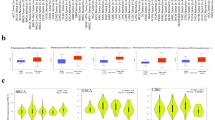Abstract
Objective
This study analyzed the role of G1 to S phase transition 1 protein (GSPT1) in promoting progression of liver cancer cells.
Methods
A bioinformatics database was used to analyze the expression levels of GSPT1 in liver cancer tissues and the prognosis of patients. Subsequently, Western blotting and quantitative PCR were used to verify the expression levels of GSPT1 between normal hepatocytes and hepatoma cells. We used a CRISPR/Cas9 system to construct knockouts of GSPT1 in HepG2 and HCCLM9 liver cancer cells. The effect of GSPT1 on liver cancer cell migration and invasion was analyzed using flow cytometry, migration, and tumor formation assays.
Results
The Cancer Genome Atlas Liver Hepatocellular Carcinoma dataset indicated that GSPT1 expression was upregulated in liver cancer cell lines, and patients with liver cancer had poor prognosis. Knockout of GSPT1 in cells significantly inhibited tumor proliferation, cell migration, and growth in vivo.
Conclusion
In this study, we found that GSPT1 promotes the migration and invasion of liver cancer cells.
Similar content being viewed by others
References
Fu J, Wang H. Precision diagnosis and treatment of liver cancer in China. Cancer Lett, 2018,412:283–288
Shi JF, Cao M, Wang Y, et al. Is it possible to halve the incidence of liver cancer in China by 2050? Int J Cancer, 2021,148(5):1051–1065
Anwanwan D, Singh SK, Singh S, et al. Challenges in liver cancer and possible treatment approaches. Biochim Biophys Acta Rev Cancer, 2020,1873(1):188314
Lim KC, Chow PK, Allen JC, et al. Systematic review of outcomes of liver resection for early hepatocellular carcinoma within the Milan criteria. Br J Surg, 2012,99(12):1622–1629
Malta-Vacas J. Differential expression of the eukaryotic release factor 3 (eRF3/GSPT1) according to gastric cancer histological types. J Clin Pathol, 2005,58(6):621–625
Chauvin C, Jean-Jean O. Proteasomal degradation of human release factor eRF3a regulates translation termination complex formation. RNA, 2007,14(2):240–245
Ivanov A, Mikhailova T, Eliseev B, et al. PABP enhances release factor recruitment and stop codon recognition during translation termination. Nucleic Acids Res, 2016,44(16):7766–7776
Sun W, Zhang L, Yan R, et al. LncRNA DLX6-AS1 promotes the proliferation, invasion, and migration of non-small cell lung cancer cells by targeting the miR-27b-3p/GSPT1 axis. Onco Targets Ther, 2019,12: 3945–3954
Lee JA, Park JE, Lee DH, et al. G1 to S phase transition protein 1 induces apoptosis signal-regulating kinase 1 activation by dissociating 14-3-3 from ASK1. Oncogene, 2008,27(9):1297–1305
Xiao R, Li C, Chai B. miRNA-144 suppresses proliferation and migration of colorectal cancer cells through GSPT1. Biomed Pharmacother, 2015,74:138–144
Tian Q, Tian R, Liu Y, et al. The role of miR-144/GSPT1 axis in gastric cancer. Eur Rev Med Pharmacol Sci, 2018,22(13):4138–4145
Malta-Vacas J, Chauvin C, Gonçalves L, et al. eRF3a/GSPT1 12-GGC allele increases the susceptibility for breast cancer development. Onco Rep, 2009,21(6):1551–1558
Cheng Z, Guo J, Chen L, et al. Knockdown of EHF inhibited the proliferation, invasion and tumorigenesis of ovarian cancer cells. Mol Carcinog, 2016,55(6):1048–1059
Kraus S, Benard O, Naor Z, et al. C-Src Is Activated by the EGF Receptor in a Pathway that Mediates JNK and ERK Activation by Gonadotropin-Releasing Hormone in COS7 Cells. Int J Mol Sci, 2020,21(22):8575
Yang Z, Sun Y, Ni Z, et al. Merging PROTAC and molecular glue for degrading BTK and GSPT1 proteins concurrently. Cell Res, 2021,31(12):1315–1318
Zhang C, Zou Y, Dai DQ. Downregulation of microRNA-27b-3p via aberrant DNA methylation contributes to malignant behavior of gastric cancer cells by targeting GSPT1. Biomed Pharmacother, 2019,119:109417
Steers WD, Mallory B, de Groat WC. Electrophysiological study of neural activity in penile nerve of the rat. Am J Physiol, 1988,254(6 Pt 2):R989–R1000
Li Z, Xie X, Fan X, et al. Long Non-coding RNA MINCR Regulates miR-876-5p/GSPT1 Axis to Aggravate Glioma Progression. Neurochem Res, 2020,45(7):1690–1699
Wang S, Beeghly-Fadiel A, Cai Q, et al. Gene expression in triple-negative breast cancer in relation to survival. Breast Cancer Res Treat, 2018,171(1):199–207
Long X, Zhao L, Li G, et al. Identification of GSPT1 as prognostic biomarker and promoter of malignant colon cancer cell phenotypes via the GSK-3beta/CyclinD1 pathway. Aging (Albany NY), 2021,13(7):10354–10368
Litchfield K, Holroyd A, Lloyd A, et al. Identification of four new susceptibility loci for testicular germ cell tumour. Nat Commun, 2015,6:8690
Miri M, Hemati S, Safari F, et al. GGCn polymorphism of eRF3a/GSPT1 gene and breast cancer susceptibility. Med Oncol, 2012,29(3):1581–1585
Nair S, Bora-Singhal N, Perumal D, et al. Nicotine-mediated invasion and migration of non-small cell lung carcinoma cells by modulating STMN3 and GSPT1 genes in an ID1-dependent manner. Mol Cancer, 2014,13(1):173
Acknowledgments
The authors thank AiMi Academic Services (https://www.aimieditor.com) for English language editing and review services.
Author information
Authors and Affiliations
Corresponding authors
Ethics declarations
The authors declare no potential conflicts of interest.
Additional information
This work was supported by grants from the National Natural Science Foundation of China (No. 81770283, No. 82070302 and No. 81902018), Clinical Medical Research Center of Peritoneal Cancer of Wuhan (No. 2015060911020462), Natural Science Foundation of Hubei Province (No. 2019CFB109), Technology and Innovation Seed Found, Zhongnan Hospital of Wuhan University (No. znpy2018004).
Supplementary data
Rights and permissions
About this article
Cite this article
Xi, Yq., Gao, Jb., Li, Xf. et al. GSPT1 Functions as a Tumor Promoter in Human Liver Cancer. CURR MED SCI 43, 104–114 (2023). https://doi.org/10.1007/s11596-022-2665-6
Received:
Accepted:
Published:
Issue Date:
DOI: https://doi.org/10.1007/s11596-022-2665-6




